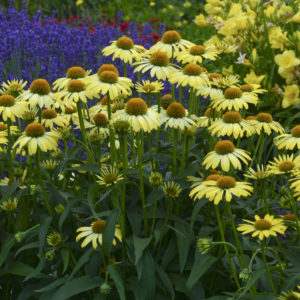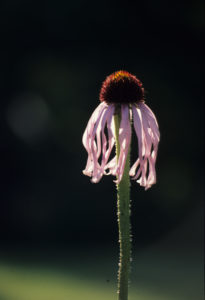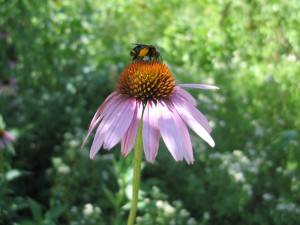Echinacea, or coneflower, is possibly one of the most well known prairie flowers. Endemic to North American prairies, it is known around the world for its medicinal properties and its versatility as a cut flower. There are ten distinct species of naturally occurring echinacea, but the horticultural industry has created countless hybrids.
Though native echinacea only comes in purple, pale purple, or yellow, hybridized echinacea can be red, orange, pink, green or even multi-color. But what besides color make these new coneflowers different? And are there any downsides to using engineered plants over natives?

‘Julia’ is a hybrid coneflower sporting vibrant orange flowers on strong stems. Photo courtesy of Walter’s Gardens.
How They Are Made: Wilderness Vs Laboratory
Most newfangled varieties of Echinacea are from the species E. purpurea. Unassuming and bright, the ‘straight species’ of Echinacea purpurea has long lasting purple blooms that readily self seed in the garden. Insects pollinate these wild coneflowers by carrying pollen (i.e. genetic material) between whatever echinaceas are nearby, producing seeds with mixed traits and variable habits. However, hybrid varieties have much more protected DNA, developed by humans through hand pollinating of flowers with desirable qualities. It can take years to successfully select, cross, and stabilize a genetic line of new coneflowers for the garden market.

This variety of Echinacea called ‘ Cleopatra’ has eye catching yellow flowers. Photo courtesy of Walter’s Gardens.
Pros
Using hybrid echinacea gives you more options. If you like to make bold statements and thematic garden designs, a wider color pallette is always more fun. The hybrid types come in all different sizes as well, meaning customers can choose tall or dwarf types to fit multiple landscaping needs. Native coneflowers, like E. pallida or E. paradoxa, will always be between 1.5-3 ft tall when planted in optimal conditions. Beyond height, genetically modified coneflowers often have better branching and a more compact habit than the native type. They are usually less prone to flopping over, and some even have a longer bloom period. For gardens with limited space, hybrid coneflowers offer lots of color in a more manageable package.

‘Salsa’ Echinacea is from the Sombrero series of coneflowers offered by Walter’s Garden. All of the varieties shown in this post will be available at our fall plant sale!
Cons
Native coneflowers are excellent food sources for pollinators, but the jury is still out on whether hybrids are as beneficial. We know that hybrid echinaceas with double and triple blooms are useless to pollinators because the extra petals block nectar and pollen. However, preliminary studies on the subject suggests some single flowered hybrids are as attractive to pollinators as their parent plants.
Additionally, some hybrid varieties are sterile and do not produce viable seeds to support seed eating birds. Humans reproduce most hybrid varieties through vegetative propagation, either by tissue culture or by cuttings and divisions. This means they are genetic clones of each other and do not contribute to genetic diversity within the Echinacea gene pool. Less genetic diversity transmitted to the next generation of plants leaves echinacea species’ at risk for disease and decay of their genetic line. Ecological considerations aside, some new varieties don’t seem to be as long lived as the true natives.
Whether or not you go with true natives or new varieties of coneflower depends on the purpose of your planting. If you want an ecological planting that increases biodiversity and improves habitat, then stick with Kansas natives. But to simply improve the aesthetics of your landscape and add a splash of color, new hybrid varieties will do the trick. Come to the FloraKansas fall plant sale and get your fill of coneflowers, native and otherwise!



